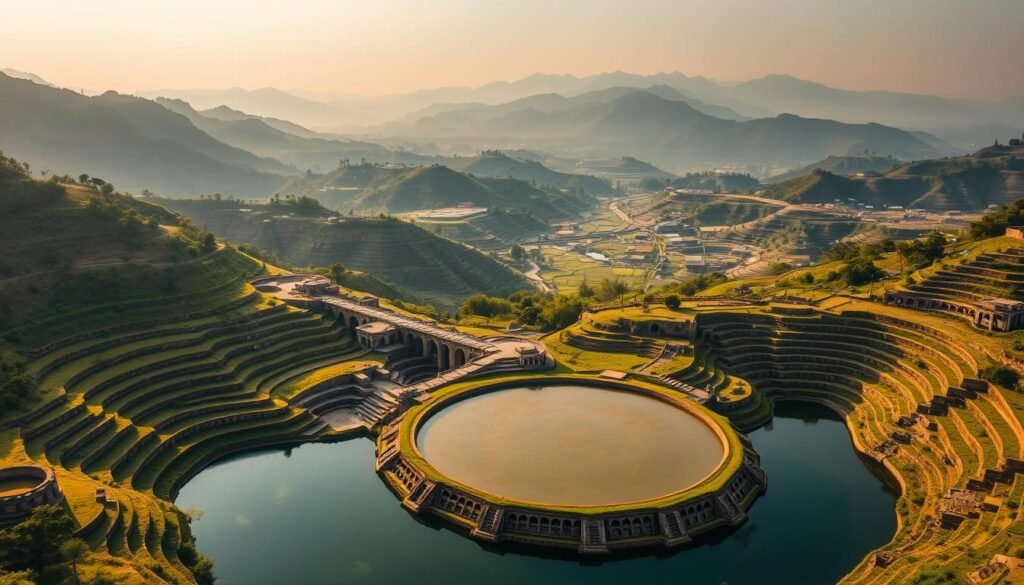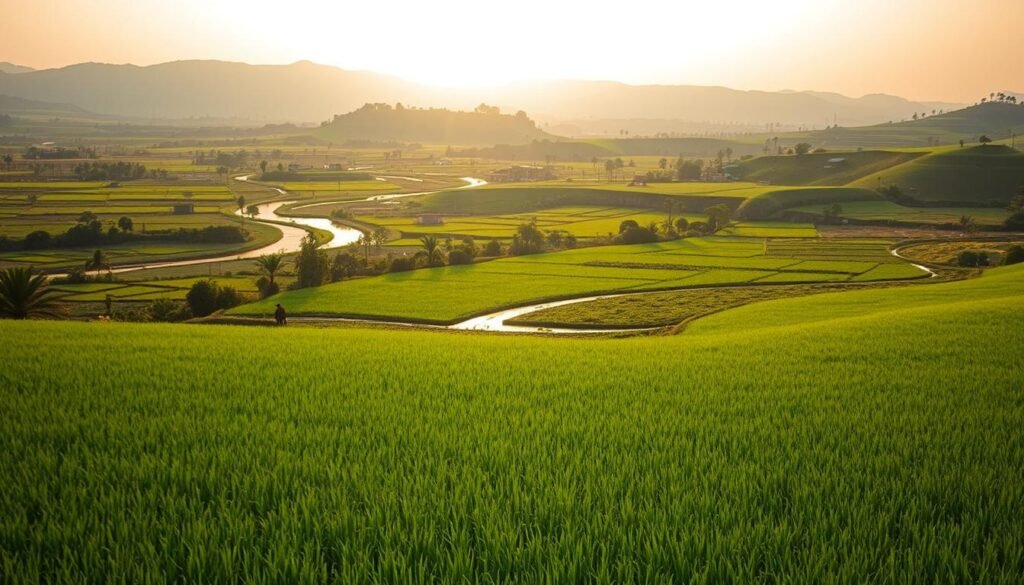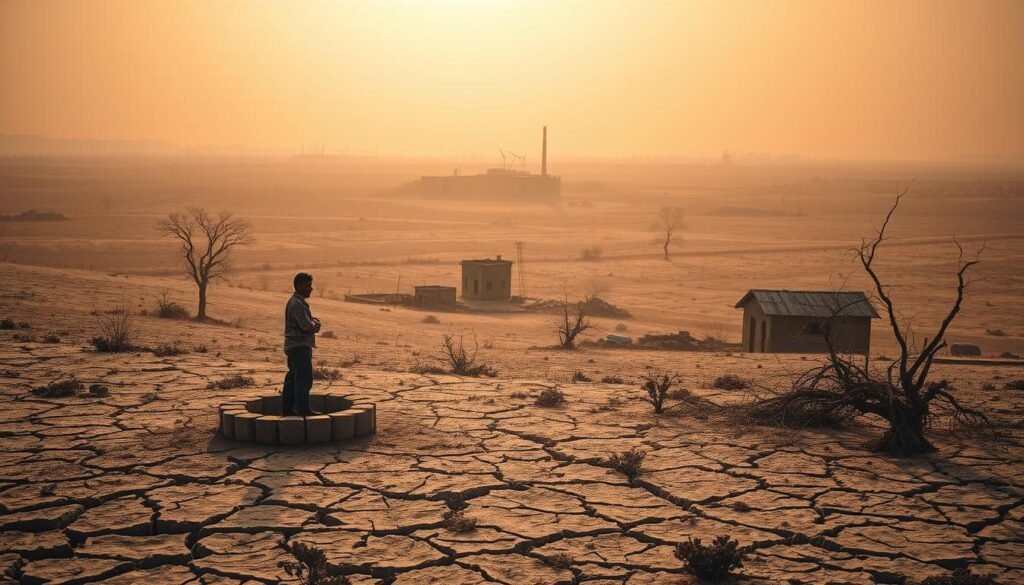Did you know over 600 million people in India face high to extreme water stress? This shows how urgent it is to tackle India’s water crisis. It affects the environment, livelihoods, and health of millions. We’ll look into groundwater depletion and sustainable water management to find solutions.
For more detailed insights on India’s water challenges, visit NITI Aayog’s Water Resources Report and learn about government initiatives. The Down To Earth – Water Crisis in India offers comprehensive coverage of environmental impacts and solutions.
We’ll explore the history of water management, the causes of scarcity, and the roles of communities and governments. Together, we can work towards innovative solutions. These solutions will help manage India’s water resources for the future.
Understanding India’s Water Crisis
The water situation in India is getting worse and needs urgent action. Groundwater depletion is a big problem, affecting both cities and rural areas. The heavy use of groundwater has made it a scarce resource.
Overview of the Current Water Situation
Over 600 million people in India face water stress. This problem comes from growing populations, farming needs, and poor water management. Groundwater depletion shows we need to save water fast.
Key Statistics and Facts
| Statistic | Value |
|---|---|
| People Facing Water Stress | 600 million+ |
| Groundwater Levels Depleted | Over 60% |
| Area Affected by Drought | 40% of India |
| Annual Groundwater Extraction | 250 billion cubic meters |
Major Areas Affected
Places like Tamil Nadu and Rajasthan are key in the water crisis talk. They often face drought, hurting farming. We must work together to save water in these critical areas.
Historical Context of Water Management in India
To understand the India water crisis, we must look at its history. From ancient times to colonial rule and today’s governance, each era has shaped water management. This journey shows how we got to where we are now.
Traditional Water Harvesting Practices
Ancient India was known for its smart water harvesting. They built step wells and Kunds to catch rainwater for the dry seasons. These systems showed how communities worked together to save water, a lesson for today’s water crisis.
Colonial Influences on Water Policies
Colonial times changed water management in India. The British saw water as a resource to be taken, not saved. This view set a path that today’s water management follows, causing problems in solving the crisis.
Recent Developments in Water Governance
Recently, India’s water governance has changed for the better. New policies focus on community involvement and local wisdom. Strategies like integrated water resource management are being used, showing a way to fix the water crisis. Working together, we can learn from the past and find new solutions.

Causes of Water Scarcity in India
Understanding why India faces water scarcity is key. Many factors lead to this crisis. They are linked to drought and the need for better water conservation.
Population Growth and Urbanization
The fast-growing population and cities put a lot of pressure on water. Cities grow quickly, making more water needed. This leads to water shortages, making droughts worse.
Climate Change Impacts
Climate change is a big threat to water. It changes rainfall and makes water sources less reliable. This leads to droughts in some places and floods in others. It’s important to find ways to deal with these changes to protect water.
Pollution and Water Quality Issues
Pollution makes clean water harder to find. It harms health, ecosystems, and farming. We need better ways to conserve water to fight pollution. This will help keep water safe and usable, reducing drought problems.
The Role of Agriculture in Water Usage
Agriculture is key to India’s economy, needing lots of water to grow. It’s the biggest user of water, affecting our water management plans. The crops we choose and how we water them impact our water and the risk of losing groundwater.
Water-Intensive Crops
Crops like sugarcane and rice use a lot of water. They are grown in many places in India. This high water use speeds up the loss of groundwater, threatening farming’s future.
Irrigation Practices and Their Efficiency
Today’s irrigation methods are not always good. Old ways like flood irrigation waste a lot of water. But, newer methods like drip irrigation can save water. It’s important to find better ways to water crops to use less water and keep farming going.
Sustainable Agricultural Practices
Switching to sustainable farming is key to solving water problems. Practices like rotating crops and using organic farming help save water. They also make soil healthier, helping it fight off climate changes. By innovating in farming, we can protect our water for the future.

| Crops | Water Requirement (liters per kg) | Current Area Under Cultivation (million hectares) |
|---|---|---|
| Sugarcane | 1,800 | 5.1 |
| Rice | 3,000 | 43.0 |
| Wheat | 1,000 | 30.0 |
Government Policies Addressing Water Issues
Government efforts are key in tackling the India water crisis. They use policies to improve water management. The National Water Policy calls for a unified approach to manage water. It aims for fair access and conservation nationwide.
National Water Policy Initiatives
The National Water Policy is a major step towards sustainable water management in India. It focuses on:
- Holistic Approach: Managing water resources across different sectors.
- Equitable Distribution: Making sure water is available to everyone.
- Participatory Management: Getting local people involved in decisions.
State-Level Water Management Strategies
States have their own plans to deal with the water crisis. Some have set up good governance systems. Others face big challenges:
| State | Strategy | Challenges |
|---|---|---|
| Maharashtra | Rainwater Harvesting Implementation | Infrastructure limitations |
| Tamil Nadu | Public Awareness Campaigns | Bureaucratic barriers |
| Gujarat | Community-Based Water Management | Lack of community engagement |
Challenges in Policy Implementation
Even with good policies, there are big hurdles to overcome. Lack of funds, slow bureaucracy, and outdated tech slow progress. Working together is key to solving the water crisis.
Community-Led Water Conservation Initiatives
Communities are key in solving water problems through new ways to save water in India. Their efforts show how important it is to involve locals in saving water. This part talks about successful projects, the help of non-profit groups, and the need for education.
Successful Case Studies
In India, many communities have made a big difference in saving water. For example, in Rajasthan, they brought back old ways of catching rainwater. This shows how old ideas can be updated to solve today’s water issues.
In Tamil Nadu, farmers worked together to manage watersheds. This effort not only raised the water table but also kept the environment healthy. These stories show how community efforts can really make a difference in water availability and quality.
Role of Non-Governmental Organizations
NGOs play a big part in helping communities save water. Groups like the Watershed Organisation Trust (WOTR) and the Center for Science and Environment (CSE) work with locals. They teach them about saving water and give them the tools to do it.
By training local leaders, NGOs make water-saving efforts more effective. This helps communities manage water better and sustainably.
Community Awareness and Education
It’s important to teach people about the need to save water. NGOs run campaigns to educate communities. They hold workshops and give out materials to teach the value of saving water.
These efforts have sparked local movements. People are now more involved in saving water. This support helps make water management projects successful.

| Initiative | Location | Impact |
|---|---|---|
| Rainwater Harvesting | Rajasthan | Increased groundwater recharge and improved local irrigation. |
| Watershed Management | Tamil Nadu | Restoration of ecosystems and replenishment of water sources. |
| Community Awareness Programs | Maharashtra | Enhanced understanding of water conservation among stakeholders. |
Technological Innovations for Water Management
Innovation is key to solving water management challenges in India. Technology helps make water use more efficient, cuts down on waste, and encourages saving water. We’ll look at smart water systems, new rainwater harvesting tech, and how desalination and recycling can help.
Smart Water Management Systems
Smart water systems use data and IoT to better manage water. They help track water use in real time. This leads to better decisions and a more sustainable water approach in India.
By using these systems, cities can use water resources better. This means less waste and more water for those who need it.
Rainwater Harvesting Technologies
Rainwater harvesting is becoming popular in cities. It collects and stores rainwater for later use. This includes rooftop collection and storage tanks.
As cities face water shortages, these systems are a big help. They show how India can manage water sustainably. Teaching people about these systems helps communities meet their water needs.
Desalination and Water Recycling
Desalination and water recycling are promising for coastal areas. They turn saltwater into freshwater. Desalination plants use filters to remove salt and impurities.
Water recycling turns wastewater into water for farming, industry, and homes. As these methods improve, they could greatly help India’s water management.
| Technology | Description | Benefits |
|---|---|---|
| Smart Water Management Systems | Utilizes IoT and data analytics for real-time monitoring and optimization of water usage. | Enhances resource allocation and reduces water waste. |
| Rainwater Harvesting | Collects and stores rainwater from roofs and surfaces. | Provides an alternative water source, promoting sustainability in urban areas. |
| Desalination | Removes salt from seawater to produce fresh drinking water. | Increases water availability in coastal regions facing scarcity. |
| Water Recycling | Processes wastewater for reuse in various applications. | Reduces environmental impact and supports water conservation efforts. |
Economic Impacts of Water Scarcity
Water scarcity in India is a big problem that affects both the environment and the economy. It impacts many areas, like farming and industry. As the water in the ground gets lower, it’s important to understand these effects to make better policies and help communities.
Effects on Agriculture and Livelihoods
The farming sector is hit hard by water shortages. Many people depend on farming for their jobs, and without enough water, food security is at risk. Farmers face lower crop yields and higher costs, which can lead to financial trouble.
Water scarcity also means higher food prices for everyone. This affects both farmers and those who buy food.
Impact on Industry and Economic Growth
Water-dependent industries see their production drop, which hurts the economy. Factories that need water to run face higher costs as water gets scarcer. This leads to less output, higher prices, and fewer jobs.
It’s key to understand these issues to create economic plans that help now and in the future.
| Sector | Impact of Water Scarcity | Potential Economic Loss |
|---|---|---|
| Agriculture | Decreased crop yields, financial instability for farmers | Loss of livelihood, higher food prices |
| Industry | Production losses, increased operational costs | Reduced economic growth, job losses |
| Overall Economy | Interconnected crises in food supply and industry | Long-term economic destabilization |

Future Outlook: Sustainable Solutions for Water Management
India faces big challenges with its water. We need to look ahead and find sustainable ways to manage it. One key idea is Integrated Water Resource Management (IWRM). It helps us understand how water is used across different areas.
This method brings together different groups to work together. It looks at the needs of farming, cities, and more. This way, we can use water better and make sure everyone gets what they need.
Integrated Water Resource Management
IWRM says water can’t be managed alone. It suggests we plan water use for all sectors. This way, we can use water more efficiently.
This approach is key for sustainable water management in India. The country’s weather changes a lot, and water is in high demand. We need to manage it well for everyone.
Feasibility of Water Pricing
Looking into water pricing is another big step. Pricing water can encourage people and businesses to save it. If water costs more, people might use it less.
This could make us value water more. It’s a big step towards better water management in India. We need to make water pricing work for everyone.
Public-Private Partnerships
Public-Private Partnerships (PPPs) are also important. They bring in private money to improve water systems. This can make water management better and more efficient.
PPPs can also bring new ideas and technology. Working together, public and private groups can find lasting solutions. This is key for sustainable water management in India.
Taking Action: How Individuals Can Contribute
The water crisis in India is a big challenge and a call to action for everyone. By taking simple steps to save water, we can make a big difference. Fixing leaks, using less water, and collecting rainwater are just a few ways to help.
These actions can greatly reduce our water use and teach others about saving water. It’s a way to make our communities more water-conscious.
Simple Practices for Water Conservation
We all can help save water in India by changing our habits. Taking shorter showers and turning off the tap while brushing teeth are easy steps. Using a broom instead of a hose for cleaning is another good idea.
Also, supporting local rainwater harvesting systems can help a lot. It reduces the demand on our limited water resources. This makes a big difference in how much water we have available.
Advocating for Better Policies
To really change things, we need to push for better water policies. We can do this by signing petitions, talking to our local leaders, and joining discussions on water management. It’s important to speak up and support plans for a greener future.
Joining Local Initiatives and Movements
Working together in our communities is also key. By joining local water-saving efforts, we can make a bigger impact. Many groups need volunteers for projects that help with water shortages and teach people how to use water wisely.
Together, we can change how our communities view water. This will help ensure a better, more sustainable future for India.




